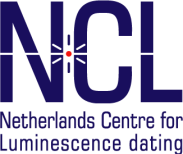About us
We develop new and improved luminescence dating methods, and we apply luminescence dating in collaboration with NCL partners and external users.
The Netherlands Centre for Luminescence dating is a collaboration of universities and research centres in The Netherlands. Wageningen University hosts the NCL and its facilities. The other NCL partners are Cultural Heritage Agency (RCE), TNO – Geological Survey of the Netherlands, Deltares, Wageningen Environmental Research, Leiden University, University of Amsterdam and Utrecht University.
Luminescence dating
Luminescence dating determines the last exposure to light or heat of natural minerals, mainly quartz and feldspar. Thereby the method can be used to determine the time of deposition and burial of sediments, or the time of baking of ceramic artefacts (pottery, brick). The method has a wide age range, covering the period from a few years to half a million years. Luminescence dating is ideally suited for aeolian and coastal deposits, but is increasingly and successfully used for a wide range of other depositional environments (e.g. fluvial, colluvial, anthropogenic). In addition, we recently co-developped new applications to investigate soil mixing processes (bioturbation rates) and sediment transport paths.
Main aims of the NCL:
- Develop new and improved methods for luminescence dating
- Make luminescence dating widely available for Netherlands research.
The NCL team
Jakob Wallinga – NCL director / researcher
Liz Chamberlain - researcher
Alice Versendaal – analyst / lab manager, member of NCL management team
Erna Voskuilen – analyst
- Unfortunately, your cookie settings do not allow videos to be displayed. - check your settings
